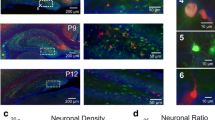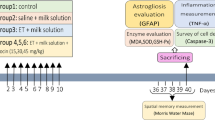Abstract
Fetal alcohol spectrum disorder (FASD) is the principal preventable cause of mental retardation in the western countries resulting from alcohol exposure during pregnancy. Ethanol-induced massive neuronal cell death occurs mainly in immature neurons during the brain growth spurt period. The cerebellum is one of the brain areas that are most sensitive to ethanol neurotoxicity. Currently, there is no effective treatment that targets the causes of these disorders and efficient treatments to counteract or reverse FASD are desirable. In this study, we investigated the effects of nicotinamide on ethanol-induced neuronal cell death in the developing cerebellum. Subcutaneous administration of ethanol in postnatal 4-day-old mice induced an over-activation of caspase-3 and PARP-1 followed by a massive neurodegeneration in the developing cerebellum. Interestingly, treatment with nicotinamide, immediately or 2 h after ethanol exposure, diminished caspase-3 and PARP-1 over-activation and reduced ethanol-induced neurodegeneration. Conversely, treatment with 3-aminobenzadine, a specific PARP-1 inhibitor, was able to completely block PARP-1 activation, but not caspase-3 activation or ethanol-induced neurodegeneration in the developing cerebellum. Our results showed that nicotinamide reduces ethanol-induced neuronal cell death and inhibits both caspase-3 and PARP-1 alcohol-induced activation in the developing cerebellum, suggesting that nicotinamide might be a promising and safe neuroprotective agent for treating FASD and other neurodegenerative disorders in the developing brain that shares similar cell death pathways.





Similar content being viewed by others
Abbreviations
- FASD:
-
Fetal alcohol spectrum disorder
- FAS:
-
Fetal alcohol syndrome
- EtOH:
-
Ethanol
- PARP-1:
-
Poly (ADP-ribose) polymerase
- FJB:
-
Fluoro-Jade-B
- PAR:
-
Polymers of ADP-ribose
- NAD+:
-
Nicotinamide adenine dinucleotide
- NADP+:
-
Nicotinamide adenine dinucleotide phosphate
- PD:
-
Postnatal days
References
May PA, Gossage JP, Kalberg WO, Robinson LK, Buckley D, Manning M, et al. Prevalence and epidemiologic characteristics of FASD from various research methods with an emphasis on recent in-school studies. Dev Disabil Res Rev. 2009;15(3):176–92. https://doi.org/10.1002/ddrr.68.
Burd L, Klug MG, Martsolf JT, Kerbeshian J. Fetal alcohol syndrome: neuropsychiatric phenomics. Neurotoxicol Teratol. 2003;25(6):697–705. https://doi.org/10.1016/j.ntt.2003.07.014.
Bonthius DJ, West JR. Alcohol-induced neuronal loss in developing rats: increased brain damage with binge exposure. Alcohol Clin Exp Res. 1990;14(1):107–18. https://doi.org/10.1111/j.1530-0277.1990.tb00455.x.
Holmes GL. Morphological and physiological maturation of the brain in the neonate and young child. J Clin Neurophysiol. 1986;3(3):209–38. https://doi.org/10.1097/00004691-198607000-00002.
Ieraci A, Herrera DG. Nicotinamide protects against ethanol-induced apoptotic neurodegeneration in the developing mouse brain. PLoS Med. 2006;3(4):e101. https://doi.org/10.1371/journal.pmed.0030101.
Ieraci A, Herrera DG. Single alcohol exposure in early life damages hippocampal stem/progenitor cells and reduces adult neurogenesis. Neurobiol Dis. 2007;26(3):597–605. https://doi.org/10.1016/j.nbd.2007.02.011.
Ikonomidou C, Bittigau P, Ishimaru MJ, Wozniak DF, Koch C, Genz K, et al. Ethanol-induced apoptotic neurodegeneration and fetal alcohol syndrome. Science. 2000;287(5455):1056–60. https://doi.org/10.1126/science.287.5455.1056.
Sowell ER, Jernigan TL, Mattson SN, Riley EP, Sobel DF, Jones KL. Abnormal development of the cerebellar vermis in children prenatally exposed to alcohol: size reduction in lobules I-V. Alcohol Clin Exp Res. 1996;20(1):31–4. https://doi.org/10.1111/j.1530-0277.1996.tb01039.x.
Lubetzky-Vilnai A, Jirikowic TL, McCoy SW. Investigation of the dynamic gait index in children: a pilot study. Pediatr Phys Ther. 2011;23(3):268–73. https://doi.org/10.1097/PEP.0b013e318227cd82.
Jirikowic TL, McCoy SW, Lubetzky-Vilnai A, Price R, Ciol MA, Kartin D, et al. Sensory control of balance: a comparison of children with fetal alcohol spectrum disorders to children with typical development. J Popul Ther Clin Pharmacol. 2013;20(3):e212–28.
Light KE, Belcher SM, Pierce DR. Time course and manner of Purkinje neuron death following a single ethanol exposure on postnatal day 4 in the developing rat. Neuroscience. 2002;114(2):327–37. https://doi.org/10.1016/S0306-4522(02)00344-5.
Siler-Marsiglio KI, Madorsky I, Pan Q, Paiva M, Neeley AW, Shaw G, et al. Effects of acute ethanol exposure on regulatory mechanisms of Bcl-2-associated apoptosis promoter, bad, in neonatal rat cerebellum: differential effects during vulnerable and resistant developmental periods. Alcohol Clin Exp Res. 2006;30(6):1031–8. https://doi.org/10.1111/j.1530-0277.2006.000126.x.
Siler-Marsiglio KI, Paiva M, Madorsky I, Pan Q, Shaw G, Heaton MB. Functional mechanisms of apoptosis-related proteins in neonatal rat cerebellum are differentially influenced by ethanol at postnatal days 4 and 7. J Neurosci Res. 2005;81(5):632–43. https://doi.org/10.1002/jnr.20591.
Bearer CF, Wellmann KA, Tang N, He M, Mooney SM. Choline ameliorates deficits in balance caused by acute neonatal ethanol exposure. Cerebellum. 2015;14(4):413–20. https://doi.org/10.1007/s12311-015-0691-7.
Cebolla AM, Cheron G, Hourez R, Bearzatto B, Dan B, Servais L. Effects of maternal alcohol consumption during breastfeeding on motor and cerebellar Purkinje cells behavior in mice. Neurosci Lett. 2009;455(1):4–7. https://doi.org/10.1016/j.neulet.2009.03.034.
Klintsova AY, Goodlett CR, Greenough WT. Therapeutic motor training ameliorates cerebellar effects of postnatal binge alcohol. Neurotoxicol Teratol. 2000;22(1):125–32. https://doi.org/10.1016/S0892-0362(99)00052-5.
Cheng DT, Jacobson SW, Jacobson JL, Molteno CD, Stanton ME, Desmond JE. Eyeblink classical conditioning in alcoholism and fetal alcohol spectrum disorders. Front Psych. 2015;6:155. https://doi.org/10.3389/fpsyt.2015.00155.
Idrus NM, McGough NNH, Spinetta MJ, Thomas JD, Riley EP. The effects of a single memantine treatment on behavioral alterations associated with binge alcohol exposure in neonatal rats. Neurotoxicol Teratol. 2011;33(4):444–50. https://doi.org/10.1016/j.ntt.2011.04.004.
Maiese K, Chong ZZ. Nicotinamide: necessary nutrient emerges as a novel cytoprotectant for the brain. Trends Pharmacol Sci. 2003;24(5):228–32. https://doi.org/10.1016/S0165-6147(03)00078-6.
Hathorn T, Snyder-Keller A, Messer A. Nicotinamide improves motor deficits and upregulates PGC-1alpha and BDNF gene expression in a mouse model of Huntington’s disease. Neurobiol Dis. 2011;41(1):43–50. https://doi.org/10.1016/j.nbd.2010.08.017.
Green KN, Steffan JS, Martinez-Coria H, Sun X, Schreiber SS, Thompson LM, et al. Nicotinamide restores cognition in Alzheimer’s disease transgenic mice via a mechanism involving sirtuin inhibition and selective reduction of Thr231-phosphotau. J Neurosci. 2008;28(45):11500–10. https://doi.org/10.1523/JNEUROSCI.3203-08.2008.
Yang J, Klaidman LK, Chang ML, Kem S, Sugawara T, Chan P, et al. Nicotinamide therapy protects against both necrosis and apoptosis in a stroke model. Pharmacol Biochem Behav. 2002;73(4):901–10. https://doi.org/10.1016/S0091-3057(02)00939-5.
Maiese K, Chong ZZ, Hou J, Shang YC. The vitamin nicotinamide: translating nutrition into clinical care. Molecules. 2009;14(9):3446–85. https://doi.org/10.3390/molecules14093446.
Alano CC, Garnier P, Ying W, Higashi Y, Kauppinen TM, Swanson RA. NAD+ depletion is necessary and sufficient for poly(ADP-ribose) polymerase-1-mediated neuronal death. J Neurosci. 2010;30(8):2967–78. https://doi.org/10.1523/JNEUROSCI.5552-09.2010.
Andrabi SA, Dawson TM, Dawson VL. Mitochondrial and nuclear cross talk in cell death: parthanatos. Ann N Y Acad Sci. 2008;1147(1):233–41. https://doi.org/10.1196/annals.1427.014.
Diaz-Hernandez JI, Moncada S, Bolanos JP, Almeida A. Poly(ADP-ribose) polymerase-1 protects neurons against apoptosis induced by oxidative stress. Cell Death Differ. 2007;14(6):1211–21. https://doi.org/10.1038/sj.cdd.4402117.
Fatokun AA, Dawson VL, Dawson TM. Parthanatos: mitochondrial-linked mechanisms and therapeutic opportunities. Br J Pharmacol. 2014;171(8):2000–16. https://doi.org/10.1111/bph.12416.
Kauppinen TM, Swanson RA. The role of poly(ADP-ribose) polymerase-1 in CNS disease. Neuroscience. 2007;145(4):1267–72. https://doi.org/10.1016/j.neuroscience.2006.09.034.
Kim MY, Zhang T, Kraus WL. Poly(ADP-ribosyl)ation by PARP-1: “PAR-laying” NAD+ into a nuclear signal. Genes Dev. 2005;19(17):1951–67. https://doi.org/10.1101/gad.1331805.
Martire S, Mosca L, D’Erme M. PARP-1 involvement in neurodegeneration: a focus on Alzheimer’s and Parkinson’s diseases. Mech Ageing Dev. 2015;146–148:53–64. https://doi.org/10.1016/j.mad.2015.04.001.
Dikranian K, Qin YQ, Labruyere J, Nemmers B, Olney JW. Ethanol-induced neuroapoptosis in the developing rodent cerebellum and related brain stem structures. Brain Res Dev Brain Res. 2005;155(1):1–13. https://doi.org/10.1016/j.devbrainres.2004.11.005.
Luo J. Mechanisms of ethanol-induced death of cerebellar granule cells. Cerebellum. 2012;11(1):145–54. https://doi.org/10.1007/s12311-010-0219-0.
Cimadamore F, Curchoe CL, Alderson N, Scott F, Salvesen G, Terskikh AV. Nicotinamide rescues human embryonic stem cell-derived neuroectoderm from parthanatic cell death. Stem Cells. 2009;27(8):1772–81. https://doi.org/10.1002/stem.107.
Yu SW, Wang H, Poitras MF, Coombs C, Bowers WJ, Federoff HJ, et al. Mediation of poly(ADP-ribose) polymerase-1-dependent cell death by apoptosis-inducing factor. Science. 2002;297(5579):259–63. https://doi.org/10.1126/science.1072221.
Outeiro TF, Grammatopoulos TN, Altmann S, Amore A, Standaert DG, Hyman BT, et al. Pharmacological inhibition of PARP-1 reduces alpha-synuclein- and MPP+-induced cytotoxicity in Parkinson’s disease in vitro models. Biochem Biophys Res Commun. 2007;357(3):596–602. https://doi.org/10.1016/j.bbrc.2007.03.163.
Yokoyama H, Kuroiwa H, Tsukada T, Uchida H, Kato H, Araki T. Poly(ADP-ribose)polymerase inhibitor can attenuate the neuronal death after 1-methyl-4-phenyl-1,2,3,6-tetrahydropyridine-induced neurotoxicity in mice. J Neurosci Res. 2010;88(7):1522–36. https://doi.org/10.1002/jnr.22310.
Bogan KL, Brenner C. Nicotinic acid, nicotinamide, and nicotinamide riboside: a molecular evaluation of NAD+ precursor vitamins in human nutrition. Annu Rev Nutr. 2008;28(1):115–30. https://doi.org/10.1146/annurev.nutr.28.061807.155443.
Goodlett CR, Horn KH, Zhou FC. Alcohol teratogenesis: mechanisms of damage and strategies for intervention. Exp Biol Med. 2005;230(6):394–406. https://doi.org/10.1177/15353702-0323006-07.
Guerri C, Bazinet A, Riley EP. Foetal alcohol spectrum disorders and alterations in brain and behaviour. Alcohol Alcohol. 2009;44(2):108–14. https://doi.org/10.1093/alcalc/agn105.
Olney JW, Young C, Wozniak DF, Jevtovic-Todorovic V, Ikonomidou C. Do pediatric drugs cause developing neurons to commit suicide? Trends Pharmacol Sci. 2004;25(3):135–9. https://doi.org/10.1016/j.tips.2004.01.002.
Jevtovic-Todorovic V, Hartman RE, Izumi Y, Benshoff ND, Dikranian K, Zorumski CF, et al. Early exposure to common anesthetic agents causes widespread neurodegeneration in the developing rat brain and persistent learning deficits. J Neurosci. 2003;23(3):876–82.
Olney JW. Focus on apoptosis to decipher how alcohol and many other drugs disrupt brain development. Front Pediatr. 2014;2:81. https://doi.org/10.3389/fped.2014.00081.
Ullah N, Lee HY, Naseer MI, Ullah I, Suh JW, Kim MO. Nicotinamide inhibits alkylating agent-induced apoptotic neurodegeneration in the developing rat brain. PLoS One. 2011;6(12):e27093. https://doi.org/10.1371/journal.pone.0027093.
Hanners NW, Eitson JL, Usui N, Richardson RB, Wexler EM, Konopka G, et al. Western Zika virus in human fetal neural progenitors persists long term with partial cytopathic and limited immunogenic effects. Cell Rep. 2016;15(11):2315–22. https://doi.org/10.1016/j.celrep.2016.05.075.
Yuan F, Chen X, Liu J, Feng W, Wu X, Chen S. Up-regulation of Siah1 by ethanol triggers apoptosis in neural crest cells through p38 MAPK-mediated activation of p53 signaling pathway. Arch Toxicol. 2017;91(2):775–84. https://doi.org/10.1007/s00204-016-1746-3.
Feng Y, Paul IA, LeBlanc MH. Nicotinamide reduces hypoxic ischemic brain injury in the newborn rat. Brain Res Bull. 2006;69(2):117–22. https://doi.org/10.1016/j.brainresbull.2005.11.011.
Ullah N, Ullah I, Lee HY, Naseer MI, Seok PM, Ahmed J, et al. Protective function of nicotinamide against ketamine-induced apoptotic neurodegeneration in the infant rat brain. J Mol Neurosci. 2012;47(1):67–75. https://doi.org/10.1007/s12031-011-9685-1.
Xu M, Lee EM, Wen Z, Cheng Y, Huang WK, Qian X, et al. Identification of small-molecule inhibitors of Zika virus infection and induced neural cell death via a drug repurposing screen. Nat Med. 2016;22(10):1101–7. https://doi.org/10.1038/nm.4184.
Andrabi SA, Kang HC, Haince JF, Lee YI, Zhang J, Chi Z, et al. Iduna protects the brain from glutamate excitotoxicity and stroke by interfering with poly(ADP-ribose) polymer-induced cell death. Nat Med. 2011;17(6):692–9. https://doi.org/10.1038/nm.2387.
Cherian PP, Schenker S, Henderson GI. Ethanol-mediated DNA damage and PARP-1 apoptotic responses in cultured fetal cortical neurons. Alcohol Clin Exp Res. 2008;32(11):1884–92. https://doi.org/10.1111/j.1530-0277.2008.00769.x.
Young C, Roth KA, Klocke BJ, West T, Holtzman DM, Labruyere J, et al. Role of caspase-3 in ethanol-induced developmental neurodegeneration. Neurobiol Dis. 2005;20(2):608–14. https://doi.org/10.1016/j.nbd.2005.04.014.
Mukherjee SK, Klaidman LK, Yasharel R, Adams JD. Increased brain NAD prevents neuronal apoptosis in vivo. Eur J Pharmacol. 1997;330(1):27–34. https://doi.org/10.1016/S0014-2999(97)00171-4.
Walsh SR, Hogg D, Mydlarski PR. Bullous pemphigoid: from bench to bedside. Drugs. 2005;65(7):905–26. https://doi.org/10.2165/00003495-200565070-00002.
Libri V, Yandim C, Athanasopoulos S, Loyse N, Natisvili T, Law PP, et al. Epigenetic and neurological effects and safety of high-dose nicotinamide in patients with Friedreich’s ataxia: an exploratory, open-label, dose-escalation study. Lancet. 2014;384(9942):504–13. https://doi.org/10.1016/S0140-6736(14)60382-2.
Olmos PR, Hodgson MI, Maiz A, Manrique M, De Valdes MD, Foncea R, et al. Nicotinamide protected first-phase insulin response (FPIR) and prevented clinical disease in first-degree relatives of type-1 diabetics. Diabetes Res Clin Pract. 2006;71(3):320–33. https://doi.org/10.1016/j.diabres.2005.07.009.
Chen AC, Martin AJ, Choy B, Fernandez-Penas P, Dalziell RA, McKenzie CA, et al. A phase 3 randomized trial of nicotinamide for skin-cancer chemoprevention. N Engl J Med. 2015;373(17):1618–26. https://doi.org/10.1056/NEJMoa1506197.
Crino A, Schiaffini R, Manfrini S, Mesturino C, Visalli N, Beretta Anguissola G, et al. A randomized trial of nicotinamide and vitamin E in children with recent onset type 1 diabetes (IMDIAB IX). Eur J Endocrinol. 2004;150(5):719–24. https://doi.org/10.1530/eje.0.1500719.
Knip M, Douek IF, Moore WP, Gillmor HA, McLean AE, Bingley PJ, et al. Safety of high-dose nicotinamide: a review. Diabetologia. 2000;43(11):1337–45. https://doi.org/10.1007/s001250051536.
Funding
A.I. was supported by the De Witt-Reader’s Digest Fellowship, and D.G.H. was supported by grants from the National Alliance for Research on Schizophrenia and Depression and the Reader’s Digest Foundation.
Author information
Authors and Affiliations
Corresponding author
Ethics declarations
All animal procedures were approved by the Institutional Animal Care and Use Committees of Weill Cornell Medical College and were conducted in accordance with the National Institutes of Health Guide for the Care and Use of Laboratory Animals.
Conflict of Interest
The authors declare that they have no conflict of interest.
Rights and permissions
About this article
Cite this article
Ieraci, A., Herrera, D.G. Nicotinamide Inhibits Ethanol-Induced Caspase-3 and PARP-1 Over-activation and Subsequent Neurodegeneration in the Developing Mouse Cerebellum. Cerebellum 17, 326–335 (2018). https://doi.org/10.1007/s12311-017-0916-z
Published:
Issue Date:
DOI: https://doi.org/10.1007/s12311-017-0916-z




